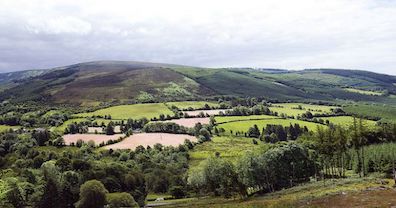Walking past the open windows of St. Joseph's National School
in Calypso, Bloom thinks of the lilting mnemotechnic
tricks that help young children learn their rudiments
("Ahbeesee defeegee kelomen opeecue rustyouvee doubleyou"),
and then of details of Irish geography that were drilled into
his head as a youngster: "Inishturk. Inishark. Inishboffin. At
their joggerfry. Mine. Slieve Bloom." "Joggerfry" was comical
school slang for "geography" in Joyce's time. The names before
and after this word refer to three islands off the western
coast of Ireland and to some low mountains in its midlands.
On the James Joyce Online Notes site John Simpson
cites a use of "joggerfry" in the 28 December 1889 issue
of Pick-Me-Up: "Girls olways gits their joggerfry
lessons better than a feller, but if they are going
anywhere they don’t know their way a bit, and they are sure to
git lost." Simpson adds that "Alternative forms of the word
were joggerfy, geogerfy, and geogerphy (all without the
reversed r and f sounds of joggerfry). At the same time as
studying joggerfry, pupils could also attempt jollogy."
Inis means island in Irish. Three small islands off
the coasts of County Mayo and County Galway, sparsely
inhabited and remote from urban civilization, are called
Inishturk, Inishbofin, and Inishark. Although all had
inhabitants in Joyce's time (Inishark has since been
abandoned), the only access would have been by fishing boat.
Like the Aran Islands a bit further south (Inishmore,
Inishmaan, and Inisheer), which Joyce visited in 1912 and
whose Gaelic-inflected idiom John
Millington Synge imitated in his plays, they would have
figured in the national imagination as bastions of ruggedly authentic Irishness—hence
perhaps their inclusion in the curriculum.
Gifford notes that the three islands lie near a part of
Galway and Mayo called the Joyce Country, so there may be some
overdetermination in their selection. As if to respond to his
creator's pride in his family name, Bloom goes on to think of
a range of mountains that bears his own surname: "Mine.
Slieve Bloom." "Slieve,"
the Anglicized form of sliabh, is the Irish word for
mountain. The Slieve Bloom are an extensive collection of
gently sloping, often forested hills, dotted with small
villages, on the borders of County Laois and County Offaly in
the center of Ireland. They are among the oldest mountains in
Europe. Millennia of erosion have reduced their height from
approximately 3,700 meters (12,000 feet) to a maximum of 527
meters (1,729 feet).



